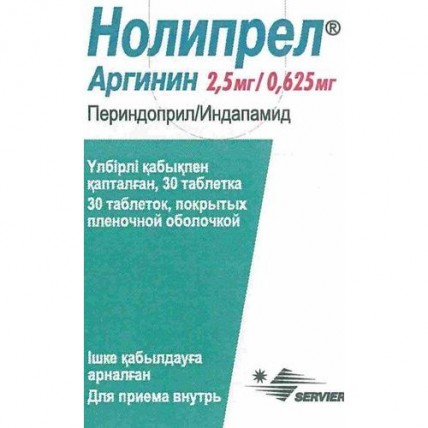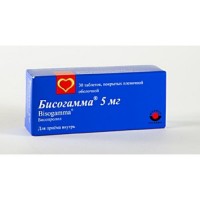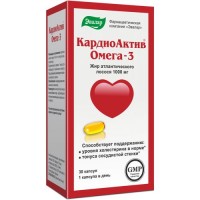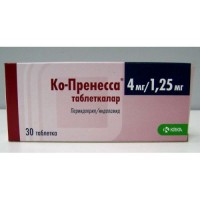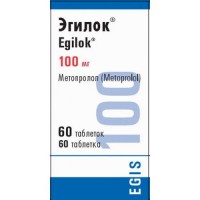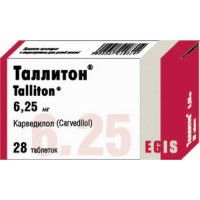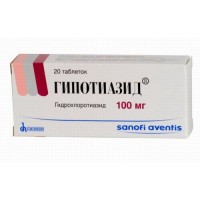The instruction for medical use of Noliprel medicine Arginine the Trade name of Noliprel Arginine the International unlicensed name Is not present the Dosage form of the Tablet, film coated Structure One tablet contains active agents: perindoprit arginine of 2.5 mg (1.6975 mg of a perindopril are equivalent) indapamid 0.625 mg, excipients: lactoses monohydrate, magnesium stearate, maltodextrin, silicon dioxide colloidal anhydrous, sodium of starch glikolit (type A), a film covering: glitserol, gipromelloza, macrogoal 6000, magnesium stearate, titan dioxide (E171). The description of the Tablet of the extended form, with a biconvex surface, coated white color, with risky on both parties Pharmacotherapeutic group Drugs for treatment of diseases of a cardiovascular system. The drugs influencing a system renin-angiotensin. AKF inhibitors in a combination with other drugs. AKF inhibitors in a combination with diuretics. Perindopril in a combination with diuretics. The ATX C09BA04 code the Pharmacological Pharmacokinetics Pharmacokinetic Properties properties of a perindopril and indapamid do not change in comparison with their separate use. Connected with perindoprily: Absorption and bioavailability At intake perindoprit quickly it is absorbed, the maximum concentration is reached within 1 hour. The half-life period of a perindopril in plasma is 1 hour. Meal reduces transformation of a perindopril in perindoprilat, and, therefore, and its bioavailability therefore perindoprit arginine it is recommended to accept once a day, orally, in the morning before a breakfast. Distribution the Volume of distribution of the untied perindoprilat makes about 0.2 l/kg. Linking of the perindoprilat with proteins of plasma makes 20%, generally binding happens about angiotensin - reformative enzyme, but depends on concentration of drug. Biotransformation Perindopril is pro-medicine. 27% of the accepted dose of a perindopril come to a blood stream in the form of an active metabolite of the perindoprilat. Except the active perindoprilat in an organism five more inactive metabolites are formed. The maximum concentration of the perindoprilat in plasma is reached in 3-4 hours after administration of drug. VyvedeniePerindoprilat is brought from an organism through kidneys, elimination half-life (T1/2) of its free fraction makes about 17 h that allows to reach steady state in 4 days. Linearity / nonlinearity It was shown that communication between a dose of a perindopril and its exposure in plasma is linear. Special categories of patients Elderly patients: Removal of the perindoprilat slows down at elderly patients and also at patients with a heart or renal failure. Renal failure: Patients with a renal failure are recommended to carry out selection of a dose taking into account extent of disturbance of renal function (clearance of creatinine). At dialysis: At dialysis the clearance of a perindopril is 70 ml/min. In cirrhosis: The kinetics of a perindopril changes at patients with cirrhosis: the hepatic clearance of an initial molecule slows down twice. However, the number of the formed perindoprilat does not decrease therefore selection of a dosage is not required (see the sections Special Instructions and Route of administration). Connected with indapamidy: Absorption Indapamid is quickly and completely absorbed from digestive tract. Cmax in plasma is reached approximately in 1 hour after reception. Distribution Linking with proteins of plasma makes 79%. Repeated administration of drug does not lead to its accumulation in an organism. Biotransformation and removal of T1/2 makes 14 - 24 hours (on average 18 hours). It is removed, generally with urine (70% of a dose) and a stake (22%) in the form of inactive metabolites. Special categories of patients Renal failure: The pharmacokinetics does not change at patients with a renal failure. The pharmacodynamics of Noliprel Arginine – irrespective of age of patients with hypertensia leads the Mechanism of action to dose-dependent decrease in diastolic and systolic arterial blood pressure as in a prone position, and standing. The hypotensive effect remains within a day. Reduction of arterial blood pressure is reached less than in one month without tachyphylaxis, the termination of treatment does not cause effect of cancellation. During clinical trials the combined purpose of a perindopril and indapamid resulted in synergy hypotensive effect in comparison with action of each of these components at separate reception. During PICXEL, multicenter randomized double blind clinical trial with active control, by means of an echocardiography estimated influence of a combination of a perindoprila/indapamid on a hypertrophy of a left ventricle in comparison with monotherapy by enalapril. In the research PICXEL the patients with hypertensia and a hypertrophy of a left ventricle (with the index of mass of a left ventricle (LVMI) & gt, men have 120 g/m2 and & gt, women have 100 g/m2) were randomizirovana in the group receiving 2 mg of a perindopril is grated - butylamine (equivalent of 2.5 mg of a perindopril of arginine) / 0.625 mg of an indapamin, or in the group receiving 10 mg of enalapril, once a day for one year of treatment. The dose was adjusted according to data of control of arterial blood pressure up to 8 mg of a perindopril is grated - butylamine (equivalent of 10 mg of a perindopril of arginine) and 2.5 indapamin or 40 mg of enalapril once a day. Only 34% of participants of a research remained on an initial dose of 2 mg of a perindopril is grated - butylamine (equivalent of 2.5 mg of a perindopril of arginine) / 0.625 mg of an indapamin (with comparison with 20%, remained on a dose of enalapril of 10 mg). At the end of treatment in all population of randomized patients LVMI decreased much more in group of a perindoprila/indapamid (-10.1 g/m ²), than in group of enalapril (-1.1 g/m ²). The difference between groups on change of LVMI made-8.3 (95% of CI (-11.5,-5.0), p & lt, 0.0001). Connected with perindoprily: Perindopril is effective in arterial hypertension of any degree: easy, moderate and heavy. Decrease diastolic and systolic arterial pressure occurs as in a prone position, and standing. The maximum of hypotensive effect is observed in 4-6 h after single dose and remains for 24 h. High degree of residual inhibition of activity angiotensin - reformative enzyme in 24 h after administration of drug - 80% is noted. At the patients responding to treatment, normalization of arterial blood pressure is reached in one month and remains without development of a tachyphylaxis. The termination of treatment does not lead to restoration of hypertensia. Perindopril has vasodilating properties and restores elasticity of the main arterial vessels, adjusts gistomorfometrichesky changes in resistant arteries and reduces a hypertrophy of a left ventricle. If necessary, addition of thiazide diuretic results in additive synergism. The combined prescribing of inhibitor angiotensin - reformative enzyme with thiazide diuretic reduces the risk of a hypopotassemia arising at intake only of one diuretic. Connected with indapamidy: Indapamid in monotherapy has hypotensive effect which remains during 24 h. This effect is shown at doses at which diuretic action of an indapamid is minimum. The efficiency of hypotensive action of an indapamid is proportional to its ability to improve elasticity of arteries, to reduce OPSS and resistance of arterioles. Indapamid promotes reduction of a hypertrophy of a left ventricle. When exceeding doses of thiazide and tiazido-like diuretics their hypotensive efficiency reaches the plateau, while undesirable effects become more and more expressed. If treatment is inefficient, then it is not necessary to increase a dose. Besides, it was shown that at short-term, medium-term and long-term treatment of the patients having hypertensia, indapamid: - does not influence metabolism of lipids: triglycerides, LDL cholesterol and LPVP cholesterol, - does not influence metabolism of carbohydrates, even at diabetics with hypertensia. Data of clinical trials on double blockade system renin-angiotensin-aldosteronovoy (SRAA): Two large randomized controlled researches (and VA NEPHRON-D (Veterans Affairs Nephropathy in Diabetes, the Research of a diabetic nephropathy conducted by the Department of Veterans Affairs) were devoted by ONTARGET (ONgoing Telmisartan Alone and in combination with Ramipril Global Endpoint Trial, the International research on comparison of efficiency of a telmisartan at monotherapy and in a combination with ramiprily) to studying the combined use of APF inhibitor and a blocker of receptors of angiotensin II. The research ONTARGET was conducted among the patients who had in the anamnesis cardiovascular or cerebrovascular diseases or diabetes of the 2nd type with signs of damage of target organs. The research VA NEPHRON-D was conducted at patients with diabetes of the 2nd type and a diabetic nephropathy. Data of these researches showed lack of significant favorable effect concerning renal and/or cardiovascular outcomes and mortality and at the same time presence of the increased risk of development of a hyperpotassemia, an acute renal failure and/or hypotension in comparison with monotherapy. Considering similar pharmakodinamichesky properties, the received results also extend to other APF inhibitors and blockers of receptors of angiotensin II. Therefore, APF inhibitors and blockers of receptors of angiotensin II should not be applied at the same time at patients with a diabetic nephropathy. The research ALTITUDE (Aliskiren Trial in Type 2 Diabetes Using Cardiovascular and Renal Disease Endpoints, the Research of advantages of an aliskiren in reduction of risk of cardiovascular and renal complications at patients with diabetes of the 2nd type) was devoted to studying advantage of addition of an aliskiren to standard therapy by APF inhibitor or a blocker of receptors of angiotensin II at patients with diabetes of the 2nd type and a chronic disease of kidneys, a cardiovascular disease, or both that, and another. The research was stopped ahead of schedule because of the increased risk of development of undesirable outcomes. Cardiovascular (CC) death and a stroke met in group of an aliskiren in comparison with group of placebo quantitatively more often, the undesirable phenomena and the serious undesirable phenomena which are of special interest (hyperpotassemia, hypotension and dysfunction of kidneys), were registered in group of an aliskiren also more often, than in group of placebo. Use for children: There are no data of use of Noliprel® of Arginin for children. Indications - essential arterial hypertension the Route of administration and doses Oral administration. Essential hypertensia of Noliprel Arginine is accepted on 1 tablet a day, it is desirable in the morning before food. If arterial blood pressure does not decrease within 1 month of treatment, then it is necessary to double a dosage. Patients of advanced age: At elderly patients the indicators of content of creatinine in plasma have to be adjusted taking into account age, weight and a floor. To patients of advanced age drug is appointed on condition of normal function of kidneys, at the same time it is necessary to control extent of decrease in the ABP. Patients with a renal failure Drug is contraindicated to patients with a renal failure of heavy degree (the clearance of creatinine (CC) less than 30 ml/min.). In a moderate renal failure (clearance of creatinine (CC) of 30-60 ml/min.) the maximum daily dose one tablet Noliprel Arginine in day. ≥ 60 ml/min. against the background of therapy the regular control of concentration of creatinine and potassium in blood plasma is necessary for patients with KK. Patients with abnormal liver functions: Drug is contraindicated to patients with a heavy liver failure. In a moderate liver failure of dose adjustment it is not required. Children and teenagers NoliprelArginin should not appoint children and teenagers up to 18 years due to the lack of data on efficiency and safety of use of drug for patients of this age group. Side effects Reception of a perindopril suppresses activity renin-angiotenzivno-aldosteronnoy of a system and tends to reduce the potassium loss caused indapamidy. At 2% of the patients undergoing treatment with Noliprel® Arginine the hypopotassemia is observed (level of potassium & lt, 3.4 mmol/l). The most frequent undesirable reactions are: - connected with perindoprily: dizziness, headache, paresthesia, vertigo, disorders of vision, tinnitus, hypotension, cough, short wind, abdominal pain, constipation, diarrhea, dysgeusia, dyspepsia, nausea, vomiting, itching, rash, muscular spasms and asthenia. - connected with indapamidy: hypersensitivity reactions, generally dermatological character, at patients with predisposition to allergic and asthmatic reactions and makulopapulezny rash. Frequency of side reactions which can arise during therapy is specified in a type of the following gradation: very often (& gt, 1/10), it is frequent (& gt, 1/100, & lt, 1/10), infrequently (& gt, 1/1000, & lt, 1/100), is rare (& gt, 1/10,000, & lt, 1/1000), is very rare (& lt, 1/10,000), frequency is not established (frequency cannot be counted according to available data). Often - Hypersensitivity reactions (generally dermatological character, at patients with predisposition to allergic and asthmatic reactions) - Dizziness, a headache, paresthesia, a dysgeusia, - Disorders of vision - Vertigo, tinnitus - Hypotension (and the effects connected with hypotension) - Cough, short wind - Abdominal pain, a constipation, diarrhea, dyspepsia, nausea, vomiting, - the Itching, rash, makulopapulezny rash - Muscular spasms - the Asthenia Infrequently - the Eosinophilia * - the Hypoglycemia *, the hyperpotassemia reversible at the treatment termination *, the Hyponatremia * - Differences of mood, a sleep disorder - Drowsiness *, a syncope * - the Cardiopalmus *, tachycardia * - the Vasculitis * - the Bronchospasm - Dryness in a mouth - Urticaria, a Quincke's disease, a purpura, a hyperhidrosis, reactions of photosensitivity *, pemphigoid * - the Arthralgia *, myalgia * - the Renal failure - Erectile dysfunction - the Stethalgia *, an indisposition *, peripheral hypostasis *, a hyperthermia * - the Increased urea content in blood *, the increased creatinine content in blood * - Falling * is rare - Exacerbation of psoriasis * - Fatigue - the Increased bilirubin content in blood - Increase in level of enzymes of a liver is Very rare - Rhinitis - the Agranulocytosis, aplastic anemia, a pancytopenia, a leukopenia, a neutropenia, hemolytic anemia, thrombocytopenia - the Hypercalcemia - Confusion of consciousness - the Stroke which is perhaps caused by very big hypotension in patients of group of high risk - Stenocardia, arrhythmia (including bradycardia, ventricular tachycardia, fibrillation of auricles), the myocardial infarction which is perhaps caused by very big hypotension in patients of group of high risk - Eosinophilic pneumonia - Pancreatitis - Hepatitis, an abnormal liver function - the Erythema mnogoformny, a toxic epidermal necrolysis, Stephens-Johnson's syndrome - the Acute renal failure - Decrease in level of hemoglobin and a hematocrit Frequency is unknown - Decrease in content of potassium with a hypopotassemia, especially considerable at some groups of the population of high risk - the Possibility of development of hepatic encephalopathy in case of a liver failure - Shortsightedness, illegibility of sight - Ventricular tachycardia like pirouette (the lethal outcome is possible) - Possible deterioration in a course of the existing sharp disseminate lupus erythematosus - Increase in level of glucose in blood - Increase in level of uric acid in blood - Lengthening of an interval of QT on the electrocardiogram * Frequency is counted by results of clinical trials regarding the by-effects revealed from spontaneous messages. Contraindications Connected with perindoprily: - Hypersensitivity to active agent or the APF-B any other inhibitor the anamnesis a Quincke's disease (Quincke's edema) connected with treatment by APF inhibitor - the Hereditary or idiopathic Quincke's disease - the Second and third trimester of pregnancy - Simultaneous use of Noliprel Arginine with the drugs containing aliskiren at patients with diabetes or a renal failure (SKF & lt, 60ml/min/1.73m ²) - the Bilateral stenosis of renal arteries or existence of one functioning kidney - the Extracorporal blood circulation leading to contact of blood with negatively charged surfaces (dialysis, haemo filtration) Connected with indapamidy: - The hypersensitivity to active agent or any other sulfanamide drug - the Heavy renal failure (the clearance of creatinine is lower than 30 ml/min.) -
Hepatic encephalopathy - the Heavy liver failure - the Hypopotassemia - As a rule, intake of this drug is not recommended in combination with not - the antiarrhytmic means causing Bouveret's ventricular disease like pirouette. - The lactation period - Due to the insufficiency of therapeutic experience of Noliprel Arginine should not be applied in the following cases: - Patients who need carrying out dialysis - At patients with not treated dekompensirovanny heart failure have a Children's and teenage age up to 18 years Medicinal interactions the General instructions connected with perindoprily and indapamidy: Not recommended combinations: Drugs litiiya: at the combined intake of lithium and APF inhibitors, cases of reversible increase in concentration of lithium in serum and toxicity cases were noted. Perindoprit the combined reception and the lity is not recommended, but if it is necessary, then it is necessary to carry out careful monitoring of level of lithium in blood serum. Combinations which demand extra care: Baclofenum: enhances expressiveness of hypotensive effect (it is necessary to control the ABP level and to adjust a dose of Noliprela Arginine). Non-steroidal anti-inflammatory drugs (NPVS) (including aspirin ≥ 3g/days): at a concomitant use of APF inhibitors together with non-steroidal anti-inflammatory drugs (for example, intake of acetylsalicylic acid according to the scheme and in the doses necessary for anti-inflammatory treatment, intake of TsOG-2 inhibitors and reception of non-selective NPVS) easing of hypotensive effect can be observed. Simultaneous use of APF and NPVS inhibitors increases risk of deterioration in function of kidneys, including development of an acute renal failure and also can cause increase in serumal level of potassium, especially in patients with the available renal failures. The combination of the specified drugs has to be used with care, especially at elderly. Patients have to receive the sufficient volume of liquid, it is also necessary to control function of kidneys when assigning the combined therapy and periodically after its end. Combinations which demand care: Imipramino-like antidepressants (tricyclic), neuroleptics: strengthening of hypotensive action and increase in risk of developing orthostatic hypotension (additive effect). Connected with perindoprily: Data of clinical trials showed that double blockade the system renin-angiotensin-aldosteronovoy (SRAA) by the combined use of APF inhibitors, blockers of receptors of angiotensin II or an aliskiren is followed by increase in frequency of the undesirable phenomena, such as hypotension, hyperpotassemia and depression of function of kidneys (including development of an acute renal failure) in comparison with use of one drug influencing RAAS (see the sections Contraindications, Special Instructions and Pharmakodinamichesky Properties. The medicines causing a hyperpotassemia: Some medicines or therapeutic groups of medicines can raise a hyperpotassemia likelihood of development: aliskiren, potassium salts, kaliysberegayushchy diuretics, APF inhibitors, blockers of receptors of angiotensin II, NPVS, heparin, immunodepressants, such as cyclosporine, takrolimus, Trimethoprimum. The combined intake of these drugs increases risk of emergence of a hyperpotassemia. The combined reception is contraindicated: Aliskiren: at the patients having diabetes or a renal failure the risk of emergence of a hyperpotassemia, deterioration in renal function, development of cardiovascular diseases and cardiovascular diseases mortality increases. Extracorporal blood circulation leads Use of methods of extracorporal blood circulation to contact with negatively charged surfaces, such as dialysis or haemo filtration with some membranes of high-permeability (for example, polyacrylonitrile membranes) and aferezy lipoproteins of low density with sulfate a dextran, are contraindicated because of risk of anaphylactoid reactions. In need of treatment of this type it is necessary to consider use of other type of a dialysis membrane or other class of antihypertensive drug. Not recommended combinations: Aliskiren: at patients, except the patients having diabetes or a renal failure the risk of emergence of a hyperpotassemia, deterioration in renal function, development of cardiovascular diseases and cardiovascular diseases mortality increases. Combination therapy with APF inhibitor and a blocker of angiotenzinny receptors: It is specified in literary data that at patients with a serious atherosclerotic illness, heart failure or diabetes with damage of a target organ the combination therapy with APF inhibitor and a blocker of angiotenzinny receptors corresponds to higher rate of development of hypotension, faint, a hyperpotassemia and deterioration in renal function (including an acute renal failure) in comparison with intake of one drug influencing renin-angiotensin-aldosteronovuyu a system. Double blockade (for example, by combination of APF inhibitor with a blocker of receptors of angiotensin II) has to be limited to single cases and be followed by careful monitoring of renal function, level of potassium and arterial blood pressure (see. Special instructions). Estramustinum: the increased risk of undesirable reactions, such as Quincke's disease (angiootek). Co-trimoksazol (Trimethoprimum / sulfamethoxazole) the Patients receiving along with co-trimoxazole (Trimethoprimum / sulfamethoxazole) can have higher risk of developing an angiodystrophia. Kaliysberegayushchy diuretics (for example, Triamterenum, amiloride, etc.), potassium (salts): A hyperpotassemia (potentially with a lethal outcome), especially in combination with a renal failure (additive giperkaliyemichesky effect). The combined reception of a perindopril with these medicines is not recommended. If the accompanying use of these drugs nevertheless is shown, then at their reception it is necessary to observe extra care and to carry out frequent monitoring of content of potassium in blood serum. Information on use of Spironolactonum in heart failure you look in the section Combinations Which Demand Extra Care. Combinations which demand extra care: Antidiabetic means (insulin, oral gipoglikemicheskiyepreparata): epidemiological researches showed that the combined intake of APF inhibitors and antidiabetic drugs (insulin, oral hypoglycemic drugs) can lead to strengthening of effect of decrease in level of glucose in blood with risk of approach of a hypoglycemia. Approach of such events is most probable in the first weeks of the combined treatment and at patients with a renal failure. Kaliynesberegayushchy diuretics: At the patients accepting diuretics, especially at patients with the lowered OCK and/or deficiency of salts the considerable lowering of arterial pressure at the beginning of therapy can be observed by APF inhibitor. Probability of hypotensive effect can be reduced by the termination of intake of diuretics, increase in OCK or consumption of salt before therapy perindoprily in a low dose with its subsequent gradual increase. In arterial hypertension if the previous treatment by diuretics caused deficit salt/lowering of OCK, it is necessary or to stop intake of diuretic before therapy by APF inhibitor with the subsequent administration of kaliynesberegayushchy diuretic, or intake of APF inhibitor needs to be begun with a low dose with its subsequent increase. In the stagnant heart failure demanding intake of diuretics, intake of APF inhibitor should be begun with very low dose, whenever possible after a preliminary dose decline of the accompanying kaliynesberegayushchy diuretic. In all cases within the first several weeks after the beginning of therapy it is necessary to carry out by APF inhibitor careful monitoring of function of kidneys (creatinine level). Kaliysberegayushchy diuretics (eplerenon, Spironolactonum): At reception of an eplerenon or Spironolactonum in doses from 12.5 mg/days to 50 mg/days and low doses of APF inhibitors: At treatment of heart failure of class II-IV (on classification of NYHA) with fraction of emission & lt, 40%, with the previous therapy the risk of development of a hyperpotassemia, with a potential lethal outcome, especially in case of non-compliance with recommendations about purpose of this combination of drugs exists APF inhibitors and loopback diuretics. Before appointing this combination of drugs, it is necessary to be convinced of lack of a hyperpotassemia and a renal failure at the patient. Within the first month of therapy once a week, and then once a month it is recommended to carry out monitoring of a kaliyemiya and creatinemia. Ratsekadotril: it is known that APF inhibitors (for example, perindoprit) are the cause of a Quincke's disease. This risk increases at their use in combination with ratsekadotrily (the drug used in acute diarrhea). mTOR-inhibitors (for example, sirolimus, everolimus, temsirolimus): the patients undergoing the combined therapy by mTOR-inhibitors can be exposed to the increased risk of developing of a Quincke's disease. Combinations which demand care: Hypotensive and vasodilating drugs: The combined intake of these drugs can lead to strengthening of hypotensive effect of a perindopril. The accompanying intake of nitroglycerine and other nitrates or other vasodilators, can lead to a further lowering of arterial pressure. Allopyrinolum, cytostatic or immunosuppressive substances, system corticosteroids or procaineamide: at the combined intake of these drugs with APF inhibitors the risk of a leukopenia Anasteziruyushchy drugs increases: APF inhibitors can enhance hypotensive effect of some anesthetizing substances (see. Special instructions). Gliptina (linagliptin, saksagliptin, sitagliptin, vildagliptin): At the patients accepting APF inhibitor the risk of developing a Quincke's disease owing to the decrease of the activity of a dipeptidilpeptidaza of IV connected with reception of a gliptin increases. Sympathomimetics: Sympathomimetics can reduce hypotensive effect of APF inhibitors. Gold: in rare instances at the patients who are at the same time receiving treatment by injection drugs of gold (sodium aurotiomalat) and APF inhibitors, including perindoprit, there were vasomotor reactions (such symptoms as rush of blood to the person, nausea, vomiting and hypotension). Connected with indapamidy: Combinations which demand extra care: The drugs capable to cause Bouveret's ventricular disease like pirouette: because of risk of approach of a hypopotassemia it is necessary to be careful at reception of an indapamid in combination with the drugs capable to cause Bouveret's ventricular disease like pirouette, such as antiarrhytmic drugs of the class IA (quinidine, hydroquinidine, Disopyramidum), antiarrhytmic drugs of class III (Amiodaronum, dofetilid, ibutilid, the bretylium, sotalol), some neuroleptics (Chlorpromazinum, tsiamemazin, levomepromazinum, thioridazine, trifluoperazin), benzamides (amisulprid, Sulpiridum, sultoprid, tiaprid), such as bepridit, sizaprid, difemanit phenyl propyl ketone derivatives (Droperidolum, a haloperidol), other neuroleptics (Pimozidum), other drugs, erythromycin in/in, galofantrin, mizolastin, moxifloxacin, pentamidine, sparfloksatsin, Vincaminum in/in, methadone, astemizol, terfenadin. Prevention of decrease in level of potassium and correction in case of need: monitoring of an interval of QT. Kaliysberegayushchy drugs: Amphotericinum B (intravenously), glucocorticoids and mineralokortikoida (system introduction), tetrakozaktid, the stimulating laxatives: strengthening of risk of decrease in level of potassium (additive effect). Monitoring of content of potassium and, if necessary, dose adjustment, special attentiveness is required at treatment by a foxglove. It is necessary to apply not stimulating depletive. Foxglove drugs: low level of potassium can strengthen toxic action of a foxglove. It is necessary to carry out monitoring of the ECG and level of potassium, and if necessary to reconsider treatment. mTOR-inhibitors (for example, sirolimus, everolimus, temsirolimus): the patients undergoing the combined therapy by mTOR-inhibitors can be exposed to the increased risk of developing of a Quincke's disease. Allopyrinolum: the concomitant use with indapamidy can increase the frequency of reactions of hypersensitivity to Allopyrinolum. Combinations which demand care: Kaliysberegayushchy diuretics (amiloride, Spironolactonum, Triamterenum): Without watching that rational combinations are useful to some patients, the hypopotassemia or a hyperpotassemia (especially at patients with a renal failure or diabetes) can still be shown. It is necessary to carry out monitoring of level of potassium of blood plasma and the ECG, and if necessary, it is necessary to reconsider treatment. Metformin: lactic acidosis against the background of intake of metformin is connected, apparently, with a functional renal failure which is caused by effect of diuretics, especially, loopback. Not to apply metformin if creatinine content in plasma exceeds 15 mg/l (135 µmol/l) at men and women have 12 mg/l (110 µmol/l). The iodocontaining contrast environment: in the considerable dehydration of an organism caused by intake of diuretic drugs the risk of developing an acute renal failure increases, especially at use of yodosoderzhashchy contrast agents in high doses. Before use of the iodocontaining drugs it is necessary to carry out rehydration. Calcium (salts): increase in content of calcium as a result of decrease in its excretion with urine is possible. Cyclosporine, takrolimus: without changes of level of the circulating cyclosporine the creatinine level in plasma, even increases at the normal content of water and electrolytes. Corticosteroids, tetrakozaktid (system way of introduction): reduce hypotensive action (the delay of salt and water caused by action of corticosteroids). Special instructions the General instructions connected with perindoprily and indapamidy: At intake of the combined drug Noliprel Arginine in low doses of considerable decrease in side reactions on drug, except a hypopotassemia, in comparison with the approved low dosages of individual components, was not
the vyyavl Develop
Hepatic encephalopathy - the Heavy liver failure - the Hypopotassemia - As a rule, intake of this drug is not recommended in combination with not - the antiarrhytmic means causing Bouveret's ventricular disease like pirouette. - The lactation period - Due to the insufficiency of therapeutic experience of Noliprel Arginine should not be applied in the following cases: - Patients who need carrying out dialysis - At patients with not treated dekompensirovanny heart failure have a Children's and teenage age up to 18 years Medicinal interactions the General instructions connected with perindoprily and indapamidy: Not recommended combinations: Drugs litiiya: at the combined intake of lithium and APF inhibitors, cases of reversible increase in concentration of lithium in serum and toxicity cases were noted. Perindoprit the combined reception and the lity is not recommended, but if it is necessary, then it is necessary to carry out careful monitoring of level of lithium in blood serum. Combinations which demand extra care: Baclofenum: enhances expressiveness of hypotensive effect (it is necessary to control the ABP level and to adjust a dose of Noliprela Arginine). Non-steroidal anti-inflammatory drugs (NPVS) (including aspirin ≥ 3g/days): at a concomitant use of APF inhibitors together with non-steroidal anti-inflammatory drugs (for example, intake of acetylsalicylic acid according to the scheme and in the doses necessary for anti-inflammatory treatment, intake of TsOG-2 inhibitors and reception of non-selective NPVS) easing of hypotensive effect can be observed. Simultaneous use of APF and NPVS inhibitors increases risk of deterioration in function of kidneys, including development of an acute renal failure and also can cause increase in serumal level of potassium, especially in patients with the available renal failures. The combination of the specified drugs has to be used with care, especially at elderly. Patients have to receive the sufficient volume of liquid, it is also necessary to control function of kidneys when assigning the combined therapy and periodically after its end. Combinations which demand care: Imipramino-like antidepressants (tricyclic), neuroleptics: strengthening of hypotensive action and increase in risk of developing orthostatic hypotension (additive effect). Connected with perindoprily: Data of clinical trials showed that double blockade the system renin-angiotensin-aldosteronovoy (SRAA) by the combined use of APF inhibitors, blockers of receptors of angiotensin II or an aliskiren is followed by increase in frequency of the undesirable phenomena, such as hypotension, hyperpotassemia and depression of function of kidneys (including development of an acute renal failure) in comparison with use of one drug influencing RAAS (see the sections Contraindications, Special Instructions and Pharmakodinamichesky Properties. The medicines causing a hyperpotassemia: Some medicines or therapeutic groups of medicines can raise a hyperpotassemia likelihood of development: aliskiren, potassium salts, kaliysberegayushchy diuretics, APF inhibitors, blockers of receptors of angiotensin II, NPVS, heparin, immunodepressants, such as cyclosporine, takrolimus, Trimethoprimum. The combined intake of these drugs increases risk of emergence of a hyperpotassemia. The combined reception is contraindicated: Aliskiren: at the patients having diabetes or a renal failure the risk of emergence of a hyperpotassemia, deterioration in renal function, development of cardiovascular diseases and cardiovascular diseases mortality increases. Extracorporal blood circulation leads Use of methods of extracorporal blood circulation to contact with negatively charged surfaces, such as dialysis or haemo filtration with some membranes of high-permeability (for example, polyacrylonitrile membranes) and aferezy lipoproteins of low density with sulfate a dextran, are contraindicated because of risk of anaphylactoid reactions. In need of treatment of this type it is necessary to consider use of other type of a dialysis membrane or other class of antihypertensive drug. Not recommended combinations: Aliskiren: at patients, except the patients having diabetes or a renal failure the risk of emergence of a hyperpotassemia, deterioration in renal function, development of cardiovascular diseases and cardiovascular diseases mortality increases. Combination therapy with APF inhibitor and a blocker of angiotenzinny receptors: It is specified in literary data that at patients with a serious atherosclerotic illness, heart failure or diabetes with damage of a target organ the combination therapy with APF inhibitor and a blocker of angiotenzinny receptors corresponds to higher rate of development of hypotension, faint, a hyperpotassemia and deterioration in renal function (including an acute renal failure) in comparison with intake of one drug influencing renin-angiotensin-aldosteronovuyu a system. Double blockade (for example, by combination of APF inhibitor with a blocker of receptors of angiotensin II) has to be limited to single cases and be followed by careful monitoring of renal function, level of potassium and arterial blood pressure (see. Special instructions). Estramustinum: the increased risk of undesirable reactions, such as Quincke's disease (angiootek). Co-trimoksazol (Trimethoprimum / sulfamethoxazole) the Patients receiving along with co-trimoxazole (Trimethoprimum / sulfamethoxazole) can have higher risk of developing an angiodystrophia. Kaliysberegayushchy diuretics (for example, Triamterenum, amiloride, etc.), potassium (salts): A hyperpotassemia (potentially with a lethal outcome), especially in combination with a renal failure (additive giperkaliyemichesky effect). The combined reception of a perindopril with these medicines is not recommended. If the accompanying use of these drugs nevertheless is shown, then at their reception it is necessary to observe extra care and to carry out frequent monitoring of content of potassium in blood serum. Information on use of Spironolactonum in heart failure you look in the section Combinations Which Demand Extra Care. Combinations which demand extra care: Antidiabetic means (insulin, oral gipoglikemicheskiyepreparata): epidemiological researches showed that the combined intake of APF inhibitors and antidiabetic drugs (insulin, oral hypoglycemic drugs) can lead to strengthening of effect of decrease in level of glucose in blood with risk of approach of a hypoglycemia. Approach of such events is most probable in the first weeks of the combined treatment and at patients with a renal failure. Kaliynesberegayushchy diuretics: At the patients accepting diuretics, especially at patients with the lowered OCK and/or deficiency of salts the considerable lowering of arterial pressure at the beginning of therapy can be observed by APF inhibitor. Probability of hypotensive effect can be reduced by the termination of intake of diuretics, increase in OCK or consumption of salt before therapy perindoprily in a low dose with its subsequent gradual increase. In arterial hypertension if the previous treatment by diuretics caused deficit salt/lowering of OCK, it is necessary or to stop intake of diuretic before therapy by APF inhibitor with the subsequent administration of kaliynesberegayushchy diuretic, or intake of APF inhibitor needs to be begun with a low dose with its subsequent increase. In the stagnant heart failure demanding intake of diuretics, intake of APF inhibitor should be begun with very low dose, whenever possible after a preliminary dose decline of the accompanying kaliynesberegayushchy diuretic. In all cases within the first several weeks after the beginning of therapy it is necessary to carry out by APF inhibitor careful monitoring of function of kidneys (creatinine level). Kaliysberegayushchy diuretics (eplerenon, Spironolactonum): At reception of an eplerenon or Spironolactonum in doses from 12.5 mg/days to 50 mg/days and low doses of APF inhibitors: At treatment of heart failure of class II-IV (on classification of NYHA) with fraction of emission & lt, 40%, with the previous therapy the risk of development of a hyperpotassemia, with a potential lethal outcome, especially in case of non-compliance with recommendations about purpose of this combination of drugs exists APF inhibitors and loopback diuretics. Before appointing this combination of drugs, it is necessary to be convinced of lack of a hyperpotassemia and a renal failure at the patient. Within the first month of therapy once a week, and then once a month it is recommended to carry out monitoring of a kaliyemiya and creatinemia. Ratsekadotril: it is known that APF inhibitors (for example, perindoprit) are the cause of a Quincke's disease. This risk increases at their use in combination with ratsekadotrily (the drug used in acute diarrhea). mTOR-inhibitors (for example, sirolimus, everolimus, temsirolimus): the patients undergoing the combined therapy by mTOR-inhibitors can be exposed to the increased risk of developing of a Quincke's disease. Combinations which demand care: Hypotensive and vasodilating drugs: The combined intake of these drugs can lead to strengthening of hypotensive effect of a perindopril. The accompanying intake of nitroglycerine and other nitrates or other vasodilators, can lead to a further lowering of arterial pressure. Allopyrinolum, cytostatic or immunosuppressive substances, system corticosteroids or procaineamide: at the combined intake of these drugs with APF inhibitors the risk of a leukopenia Anasteziruyushchy drugs increases: APF inhibitors can enhance hypotensive effect of some anesthetizing substances (see. Special instructions). Gliptina (linagliptin, saksagliptin, sitagliptin, vildagliptin): At the patients accepting APF inhibitor the risk of developing a Quincke's disease owing to the decrease of the activity of a dipeptidilpeptidaza of IV connected with reception of a gliptin increases. Sympathomimetics: Sympathomimetics can reduce hypotensive effect of APF inhibitors. Gold: in rare instances at the patients who are at the same time receiving treatment by injection drugs of gold (sodium aurotiomalat) and APF inhibitors, including perindoprit, there were vasomotor reactions (such symptoms as rush of blood to the person, nausea, vomiting and hypotension). Connected with indapamidy: Combinations which demand extra care: The drugs capable to cause Bouveret's ventricular disease like pirouette: because of risk of approach of a hypopotassemia it is necessary to be careful at reception of an indapamid in combination with the drugs capable to cause Bouveret's ventricular disease like pirouette, such as antiarrhytmic drugs of the class IA (quinidine, hydroquinidine, Disopyramidum), antiarrhytmic drugs of class III (Amiodaronum, dofetilid, ibutilid, the bretylium, sotalol), some neuroleptics (Chlorpromazinum, tsiamemazin, levomepromazinum, thioridazine, trifluoperazin), benzamides (amisulprid, Sulpiridum, sultoprid, tiaprid), such as bepridit, sizaprid, difemanit phenyl propyl ketone derivatives (Droperidolum, a haloperidol), other neuroleptics (Pimozidum), other drugs, erythromycin in/in, galofantrin, mizolastin, moxifloxacin, pentamidine, sparfloksatsin, Vincaminum in/in, methadone, astemizol, terfenadin. Prevention of decrease in level of potassium and correction in case of need: monitoring of an interval of QT. Kaliysberegayushchy drugs: Amphotericinum B (intravenously), glucocorticoids and mineralokortikoida (system introduction), tetrakozaktid, the stimulating laxatives: strengthening of risk of decrease in level of potassium (additive effect). Monitoring of content of potassium and, if necessary, dose adjustment, special attentiveness is required at treatment by a foxglove. It is necessary to apply not stimulating depletive. Foxglove drugs: low level of potassium can strengthen toxic action of a foxglove. It is necessary to carry out monitoring of the ECG and level of potassium, and if necessary to reconsider treatment. mTOR-inhibitors (for example, sirolimus, everolimus, temsirolimus): the patients undergoing the combined therapy by mTOR-inhibitors can be exposed to the increased risk of developing of a Quincke's disease. Allopyrinolum: the concomitant use with indapamidy can increase the frequency of reactions of hypersensitivity to Allopyrinolum. Combinations which demand care: Kaliysberegayushchy diuretics (amiloride, Spironolactonum, Triamterenum): Without watching that rational combinations are useful to some patients, the hypopotassemia or a hyperpotassemia (especially at patients with a renal failure or diabetes) can still be shown. It is necessary to carry out monitoring of level of potassium of blood plasma and the ECG, and if necessary, it is necessary to reconsider treatment. Metformin: lactic acidosis against the background of intake of metformin is connected, apparently, with a functional renal failure which is caused by effect of diuretics, especially, loopback. Not to apply metformin if creatinine content in plasma exceeds 15 mg/l (135 µmol/l) at men and women have 12 mg/l (110 µmol/l). The iodocontaining contrast environment: in the considerable dehydration of an organism caused by intake of diuretic drugs the risk of developing an acute renal failure increases, especially at use of yodosoderzhashchy contrast agents in high doses. Before use of the iodocontaining drugs it is necessary to carry out rehydration. Calcium (salts): increase in content of calcium as a result of decrease in its excretion with urine is possible. Cyclosporine, takrolimus: without changes of level of the circulating cyclosporine the creatinine level in plasma, even increases at the normal content of water and electrolytes. Corticosteroids, tetrakozaktid (system way of introduction): reduce hypotensive action (the delay of salt and water caused by action of corticosteroids). Special instructions the General instructions connected with perindoprily and indapamidy: At intake of the combined drug Noliprel Arginine in low doses of considerable decrease in side reactions on drug, except a hypopotassemia, in comparison with the approved low dosages of individual components, was not
the vyyavl Develop
